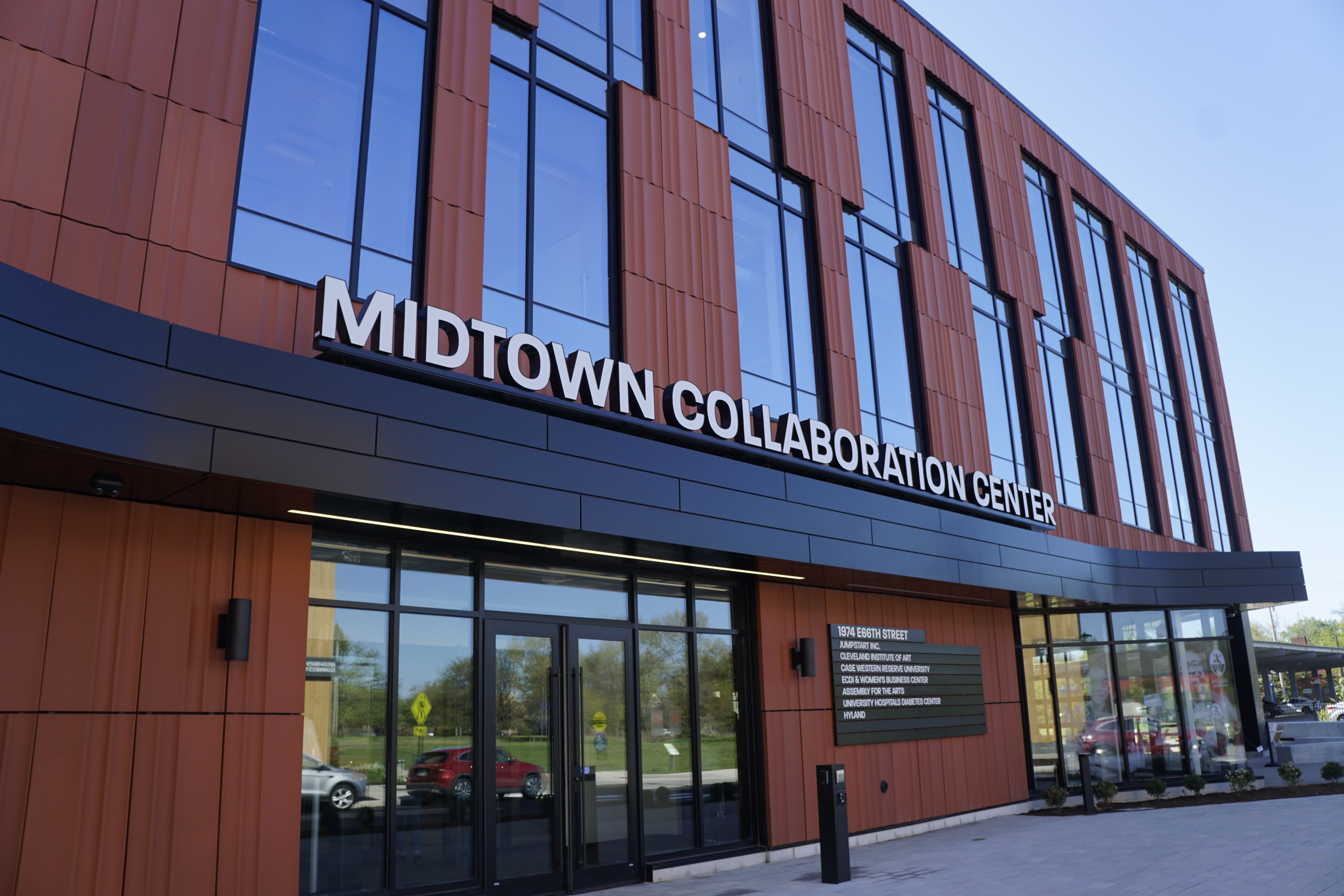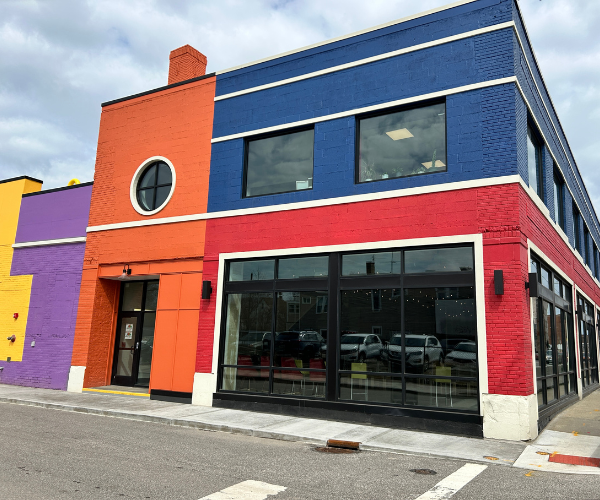The Story Of One Couple's Birthing Journey
by Rebecca Meiser | Jun. 10, 2019 | 12:00 PM

PHOTOGRAPHED BY SUZANNE PRICE
Ellis’ hat is too big.
Instead of fitting snugly over his newborn head, the cream-colored wool cap with the floppy bear ears keeps sliding over his eyes.
Sitting in the backseat on the way home from the hospital, his mom, Christine Wisnieski, keeps trying to push it back up. At just 5 pounds, 12 ounces, Ellis is tiny. When he sleeps, his face looks like that of an old, wise, wizardly man.
I am so lucky, Christine thinks, as she gazes at his smooth, still eyelash-free face. So lucky to be alive, so lucky to be going home, so lucky to have this family.
As if sensing his mom’s thoughts, Ellis lets out a small, screechy pterodactyl sound that makes his parents laugh.
A few minutes later, Christine and her husband, Kevin, pull up in front of their Cleveland Heights home, the one they bought a few years ago, dreaming that one day it would be filled with the sound of pattering children’s feet.
They couldn’t imagine then that it would take them seven years — three miscarriages, three lost embryos, two egg retrievals, four egg transfers, seven uterine surgeries — to get there. Nor could they imagine they would almost lose Christine in the process. Or how much they would lose — but also gain — in this time.
Now, as they walk up to the house, Kevin looks down at his son still snuggled in his carrier.
“Welcome home, Ellis,” he says softly.
“Maybe this journey isn’t so much about becoming anything. Maybe it’s about unbecoming everything that really isn’t you so you can become who you were meant to be in the first place.”
Christine always wanted to be a mother.
But when she first met Kevin her freshman year at Kent State University in 1997, motherhood wasn’t exactly at the top of her mind. Instead, Christine was enjoying getting to know this introspective, hardworking blond guy, who she’d first seen in a photo in her friend’s dorm.
He’d been wearing a black leather jacket and a crooked grin in the photo — and she’d kind of fallen for him, right then. He was a fixer, always trying to make things right and better, whether it was a friend’s paper or someone’s flat tire. Christine loved him for this.
“I knew from the moment I met him I wanted to have his children,” she laughs.
Kevin felt just as strongly about Christine, a social, ambitious design student who laughed easily and unabashedly. Even then, she was maternal — bringing snacks to parties (in case anyone got hungry, she says) and sitting up with drunk friends to make sure they were OK.
“She was easily the most caring person I knew,” Kevin recalls.
Since they first got together in 1998, things between them were easy. After four years of dating, it seemed natural that Kevin and Christine would continue this path together.
“We sort of inspired each other,” Christine says. “Life was better together. It was easier. It was more fun. There wasn’t anything we couldn’t do or handle together.”
The two got engaged in 2002 and married in 2003 at St. Michael’s Church in Independence. At the reception, relatives laughed and toasted the couple, telling them they’d make beautiful babies.
Christine’s best friend, Bethany Cocco, was one of the most enthusiastic celebrants, spinning around the dance floor in a long black dress and flowing black scarf. Bethany frequently talked dreamily of her and Christine having children at the same time, so they could grow up closely (although Bethany lived in New York).
Christine and Kevin wanted children too. They wanted to raise good people together, who would hopefully go on to make the world a better place.
But first Christine and Kevin wanted to build careers and a stable home. Christine started as a graphic designer downtown and Kevin worked as an engineer at Applied Medical Technology. They bought a home in Middleburg Heights and traveled to places like Italy and San Francisco. Children were on their mind, but time felt elastic — like it could stretch forever.
“It seems naive now,” Kevin says. “We just assumed children would be easy to have.”

“Be gentle on us world … We are always healing and we are trying our best to remain present.”
Christine and Kevin were in their early 30s when they started talking seriously about starting a family. They were going to as many baby showers and birthdays as bars, and their careers were on the upswing.
Christine had started her own design company, Studio of Christine Wisnieski, and her handmade stationery had been recently featured in Martha Stewart Living. Kevin had finished business school at Case Western Reserve University, and was rapidly moving up in his company. The timing felt right.
In March 2012, Christine felt a little off. So she decided to buy a pregnancy test — her first one ever. She walked into their bathroom early one morning and peed on the stick. “I didn’t know if I was doing it right,” she says.
When a blue plus sign appeared, she blinked hard and ran to wake Kevin, waving the positive sign in his face. “We were kind of like, Wow, OK, it worked,” she says.
Christine immediately called to get a doctor’s appointment. The receptionist told her it was too early to come in — but Christine pushed, and they relented.
A few weeks later, Christine walked into her then-doctor’s office for an ultrasound. Two techs were in the room. They rubbed gel on her belly and projected an image of her uterus on a large screen. The techs were quiet for a while as they moved around the wand. Finally one of them said, “The sac is empty.”
Christine had had a miscarriage. At first, she mulled over the strangeness of the words “empty sac.” Like an overnight bag that had been emptied?
Then, she felt guilty. “Like I did something wrong. Like I failed,” she says.
She called Kevin from the car, sobbing. He left work to come home and sit with her. Slowly, they calmed themselves down.
It just wasn’t meant to be, they reassured themselves. They didn’t tell anyone about the appointment or the miscarriage.
“Christine had gotten pregnant so easily,” Kevin recalls. “We figured we would simply try again soon.”

“This journey we’ve experienced has been overwhelmingly defining for me. I am attached to it in so many ways. I hate it for the pain but appreciate the pain for what it has yielded — someone who is broken and whole at the same time. I do believe we can be broken apart to be put together better than before.”
Two years passed both quickly and slowly for Christine and Kevin. Two birthdays. Two Christmases. Eight seasons changing without another positive pregnancy test.
Frustrated, they turned to University Hospitals’ fertility clinic in 2014. “We figured we must just have had the timing off,” Christine says.
To assist in the process, Christine and Kevin decided to try intrauterine insemination, or IUI, a fertility treatment where sperm is directly injected into the uterus to increase the chance of fertilization. It had worked for their friends, they figured, why not them?
Christine had her first intrauterine insemination on her 35th birthday. Over candles that night, she silently wished for a child.
“We wanted to share ourselves with someone,” she explains. “Share our time, our lives, our home, our savings, our dedication, our work ethic.”
They also wanted to share a child with the ones they loved. “We wanted our parents to have the opportunity to be grandparents. Our grandparents to be great-grandparents,” Christine says.
The first treatment didn’t work. Neither did the second two IUI treatments.
So they started to seriously consider in vitro fertilization, or IVF — an expensive, drawn-out assisted reproductive technology process that involves stimulating and extracting eggs. These eggs are manually fertilized with sperm in a lab. The healthiest surviving embryos are then transferred to the uterus with the hope that they will thrive.
During a 3D scan in spring 2014, Christine and Kevin learned she had a uterine abnormality. Instead of normally developing into one clean, whole cavity, Christine had a small separation in the top of her uterus. Sometimes, septate uteruses can increase miscarriage rates.
But Christine’s septum was small, her doctors said. Her cavity measurements were in the normal range. Many people have normal pregnancies and deliveries without ever knowing they had a septate uterus.
Christine and Kevin were left with two primary options. They could try surgery to remove the septum or they could move straight to IVF. Time no longer felt elastic. It felt like a boa constrictor around Christine’s neck.
“I worried that the surgery would delay the cycle even more,” she says.
She feared that interceding with her uterus might actually make it harder for her to get pregnant. But if the septum was impeding their chances at a healthy pregnancy, shouldn’t they at least try to remove it?
Unable to decide, they chose the fail-safe option: Draw a piece of paper from a hat. “It’s how we solve all our most difficult questions,” Kevin laughs.
One Saturday morning, they wrote out both options and threw them in an old hat of Kevin’s grandfather’s. Kevin fished out the paper which read IVF. Christine was relieved.
“It felt like the right decision,” she says.
Christine began the process of preparing for egg stimulation and retrieval. But all the while, she and Kevin didn’t stop trying to conceive naturally.
One day, on the way to the studio, Christine picked up a pregnancy test. It was an old habit, by now. For the past few years, she’d been taking them constantly. Conditioned by all the negative signs, she almost didn’t even bother looking at the results.
But this time, she saw a plus sign. “I was like Holy shit,” she says.
She was taking Lupron, a drug that suppresses ovulation, so she didn’t know how it happened. But it didn’t matter: she was pregnant. She immediately texted Kevin a photo.
They were thrilled and relieved. Now they wouldn’t have to proceed with weeks of ultrasounds, drugs and surgery.
But their joy was mixed with guilt and sadness. Christine’s best friend Bethany had recently been diagnosed with stage 4 lung cancer and returned to Cleveland to be with her family. It felt strange to celebrate life at the same time they were bracing for possible death. “I felt very selfish,” Christine says. “She always very much wanted children.”
So Kevin and Christine once again chose to keep their pregnancy secret. Christine’s focus turned toward her friend’s comfort. Between trips to the lab to make sure her pregnancy hormones were still climbing appropriately, Christine spent long afternoons with Bethany, cooking dinners, getting pedicures and watching the World Cup.
In October 2014, after her friend’s experimental cancer treatment failed, Christine visited Bethany at UH Seidman Cancer Center. There, Bethany pushed at the hospital food, talking dreamily about real food — steaming bowls of pho with slithery, long rice noodles.
Christine propped up pillows around Bethany and said she’d be right back. In her car, Christine raced to MidTown for pho, but stopped first at her office to pick up blue-and-white ceramic bowls and real silverware.
As she got back into her car, Christine’s phone lit up with the number of her doctor’s office. Her heart sank.
The blood test she’d taken earlier that morning showed her hormone numbers weren’t doubling, indicating a potential problem with the pregnancy. She called Kevin on the way back to the hospital.
But she said nothing about the pregnancy to Bethany. She just sat with her friend, slurping noodles and recounting memories.
Two days later, Bethany died.

“It was a storm within a storm. You can’t organize thoughts, make rational decisions, you just do and be. We were numb. We almost couldn’t feel anything because it all was just too much to bare [sic]. So, we boxed up the pain of our loss and put it on a shelf to protect our hearts. We’d come back for it when we were ready.”
their doctor determined it was an ectopic pregnancy. Just bad, random luck that the fertilized egg had implanted outside Christine’s uterus, where it couldn’t grow.
While ectopic pregnancies affect about 1 in every 50 pregnancies in the United States, the good news was that her fallopian tubes hadn’t ruptured. They’d caught it early.
Following Bethany’s memorial service and a trip to recover from surgery in California, Christine and Kevin decided to try IVF one more time. And again, right before the egg retrieval protocol, Christine became pregnant.
This time, they allowed themselves to feel hopeful. They had paid their dues. The previous times had been flukes. This was their real turn. How could it be otherwise?
They found out on July 4, 2015 and started telling family and close friends right away. At two months, Christine began to show. She loved wearing long, free flowing dresses and taking luxurious naps in their sunroom, windows open, with the light streaming in. “It felt like sleeping in the sun,” she says.
Kevin, who was not particularly superstitious, really believed that everything was aligned. In the past year, he had started regularly attending St. Patrick’s Church — and the baby was due on St. Patrick’s Day.
That had to mean something, right?
But then the spotting began. Not heavy. Just sort of there, every time Christine used the restroom. “I knew immediately something was wrong,” she says. “All I could think of was that I wanted to go back to yesterday, the day before it started.”
An ultrasound confirmed what Christine had already suspected: There was no heartbeat. Another miscarriage.
Christine and Kevin were devastated. “It was like, ‘Really, world?’ ” Kevin says. “ ‘You can’t cut us any sort of break?’ ”
But the duo were nothing if not persistent. Plus, they knew firsthand the joy and vibrancy it felt to carry a pregnancy. For the past few months, they had allowed themselves, for the first time, to indulge in what life might look like as a family of three. “It was hard to let go of that vision,” Christine says.
“When you know you can get pregnant, [and] do get pregnant, it is a magical feeling that you want more of,” Kevin adds.
Christine underwent a slew of surgeries starting in late 2015. In September, she had a dilation and curettage to remove the remnants of conception, followed by a similar procedure in October. On Dec. 23, Christine had outpatient surgery to remove the uterine septum.
In May 2016, she underwent an egg retrieval, followed by a procedure to implant the egg. When that procedure failed to result in pregnancy, they transferred another egg a few months later. That one didn’t take either.
Christine didn’t understand. “All of a sudden we stopped being able to get pregnant,” she says. “It didn’t make sense.”
Doctors started advising Christine to look into a gestational carrier — someone who could carry a baby in place of her.
The doctors said the problem could be with her uterine lining, which was often thin and fluid filled, and could cause implantation problems. So in December, they tried an experimental surgery to regenerate the lining’s cells and scrape out more of her septum.
In February 2017, Christine underwent another transfer. It was also unsuccessful. So she tried IUI again. “We were reaching,” Christine says. “We were grabbing.”
The couple decided to talk about their journey. They launched the Instagram account
@comeondolly, named for the moniker they’d playfully given Christine’s uterus, to share their story in posts detailing their doctor visits and discussing their most intimate dreams and fears. They hoped to raise their spirits.
“It felt freeing to put it all out there,” says Christine. “It meant that we didn’t have to tell the story 500 times if it didn’t go right.”

“So much of us is this journey. It has hurt us, it has changed us, it has empowered us, it has taken our breathe [sic] away, but we’ve have [sic] fought religiously to get hope back … We named my uterus Dolly last year (anything by Dolly Parton is my life theme) so we would think of her in the most positive light, just like a dear friend.”
It was their last resort.
In May 2017, Kevin and Christine flew to Denver for an appointment at the Colorado Center for Reproductive Medicine. The clinic, which specializes in what they call “poor responders,” attracts a worldwide clientele.
Dr. Robert Gustofson, who became Christine and Kevin’s doctor, has treated patients from as far away as Australia, Ireland and Bolivia. “We have high success rates because we do really aggressive evaluation, diagnostics and research,” he says.
Christine underwent a score of tests, which showed that she had some lingering scar tissues, irregular lining, a polyp in her lower uterine area and inflamed tissues. But with some antibiotics and surgical “clean-up,” Gustofson believed they might be able to get her uterus back in working form — and strong enough to hold and keep a pregnancy. In September, she flew out for surgery.
One month later, Christine was back in Gustofson’s office for the results. “I was ready for him to tell us that the uterus didn’t look happy and we were going to have to go the route of the carrier,” she says.
Instead Gustofson told her the uterus looked healthy and they could proceed.
Still, he wanted Christine to undergo another egg retrieval procedure in Colorado. Although they still had three perfectly good embryos in a freezer in Cleveland, Gustofson wanted to oversee the whole process, using the center’s strict chromosomal screening and protocols. They’d come this far, so the duo agreed and prepped for a March retrieval.
A few weeks before the retrieval, Christine received a call from her doctor at UH. She told Christine to sit down. She had some news.
There had been a problem with Christine and Kevin’s remaining embryos — leaving them nonviable. Kevin and Christine were in too much pain and delayed shock to ask questions at the time. Christine had to prepare for her upcoming egg retrieval in Colorado — which was now even more urgent.
When Christine awoke from surgery, she learned they had retrieved 21 eggs (of which two were later determined to be nearly perfect embryos). Overcome with happiness, she cried — and the nurse cried with her.
The day of the transfer, June 18, 2018, Gustofson had a good feeling. “I try to stay optimistic all the time, because I think optimism really helps,” he says. “But deep down, I did have a nonclinical impression that this would work.”
Two weeks later, Christine was in the car when she got a call. “Congratulations,” Gustofson told her. “You are very pregnant.”
Christine knew she wasn’t out of the woods. First, there was the spotting. Although Dr. Dinkar Rao, Christine’s OB/GYN at the Cleveland Clinic, told her this was very common for IVF patients, she couldn’t shake what had happened before.
“I constantly worried I was losing the pregnancy again,” says Christine.
Yet the pregnancy kept progressing. At seven weeks, Christine and Kevin heard a heartbeat. At 13 weeks, they celebrated making it past the first trimester. But then at 18 weeks, a screen for spina bifida came back abnormal.
“Nothing has been easy for us through the pregnancies,” Kevin says.
They went in for an ultrasound. While there was no sign of spina bifida, doctors spotted a problem.
Blood vessels connecting the fetus to Christine’s placenta were very close to the opening of her cervix, a condition called vasa previa, that put the vessels at risk for rupturing during labor. If that happened, oxygen could be cut off, endagering the baby’s life.
Rao ordered bed rest for Christine at 32 weeks and a cesarean delivery at 34 weeks.
By week 28, they allowed themselves to feel a bit of optimism. Doctors thought Christine didn’t have vasa previa after all, but rather placenta previa, a much less severe condition, which doesn’t have the same risks and wouldn’t require bed rest.
“For the first time, I felt like I was enjoying being pregnant,” Christine says.
In December, they had a baby shower. In January, they finally put together the nursery. And on Feb. 7, they went to Hillcrest Hospital for Christine’s C-section.
* * * * *
“These are 2 different women. The woman on the right is older, wiser, stronger. For the first time in years she is not riddled with doubt — she believes her body. She is strong, patient, persistent, hope-filled and knows everyday habits yield results. … She doesn’t believe in perfection because it isn’t possible but she is damn sure talking [sic] good and dedicating time to herself.”
The surgery was scheduled for 9:30 a.m.
Christine had been allowed to choose the music that played throughout the room, so as she lay there, the room filled with the twangy, country tunes of John Denver.
As Rao began to prepare for the incision, Kevin squeezed her hand. And thirty minutes later, their healthy son, Ellis, came out crying.
He was pink and wrinkly and skinny. His eyes were open, and he seemed alert.
But something was wrong. “I looked down at the ground and saw a pool of blood starting to come toward me,” Kevin says.
Christine was white in the face and hemorrhaging. Her placenta had grown into the wall of her cervix and uterus, a condition called placental accreta. There was no way to clamp the bleeding.
Rao ordered units of blood into the room. Although the condition hadn’t been seen on any of Christine’s previous scans, the doctor was prepared.
“We need to do a hysterectomy,” he told Christine, or her body might go into shock.
“Do whatever you need,” she said. On the bed, her mouth tasted like pennies.
An attendant moved Ellis and Kevin to the nursery for observation while an anesthesiologist held Christine’s hand.
Kevin stood, staring in shock and wonder at his new son, while worrying what would become of his wife.
Christine not making it through the birth had always been a concern — something Kevin had tried to push away. But with all they had gone through, it was not outside the realm of possibility.
“We never really talked about it together,” he says. “I don’t think we wanted to.”
When Christine woke up in the ICU hours later, she was stable. She lost 6 liters of blood — half of her body’s volume at the time. But she had not gone into shock, which would have prevented her organs from getting the oxygen they needed.
Christine lost her right fallopian tube, her cervix and her uterus — but she still had her left tube and ovaries. She would not go into premature menopause and the worst danger had passed.
Four days later, Christine, Kevin and Ellis all left the hospital together, ready to settle into life as a family.

On a Wednesday night in April, Kevin sits in a rocker in their sunroom, holding Ellis, who is asleep with his mouth forming a perfect “O.”
Sitting across from her boys, Christine looks at them, smiles and tears up. She has spent much of the past three months since Ellis’ birth trying to heal herself, while also focusing on getting Ellis’ weight up.
They were on a constant two-hour feeding cycle. Now that he has finally gotten back to his birth weight, she’s had more time to reflect and relax into motherhood.
“The other night, I woke up and saw Ellis sleeping on Kevin’s chest, and I could see how much they looked alike,” she says.
The family calls Ellis their “miracle child.” At times, it all still feels so unreal. “ ‘Son’ is a word, I almost don’t know what it means,” Christine says.
But flipping back through old Instagram photos brings everything back. “I still can’t believe some of it. It takes you back to this emotional place,” Christine says. “It reminds me how we fought so hard for this. It helps you never take anything for granted.”
Today, @comeondolly is no longer a story about infertility. It is the story of a birth. It is the story of a squirming 3-month-old with chipmunk cheeks, beginning to explore the world. It is the story of a seven-year journey and of a loving couple who came to discover their own strength and resiliency.
“There isn’t anything about [our story] that I would change,” Kevin says. “It would be easy to say that we’ve lost all this time. But had it been an easier journey for us, I can’t even picture how our lives would be now. Our lives have changed so much for the better for having gone through this.”
“Well, I might have changed the delivery,” Christine interjects, with a slight smile.
And their story continues — in real life and on Instagram. In recent weeks, Christine has written about embracing her postpartum body and problems trying to get Ellis to latch during breastfeeding.
“We started out not telling anyone anything,” she says. “But through this process, you realize that sometimes you just need to tell people what’s going on.”
And it will someday become a personal history for their son. “I think it will be really healthy for Ellis to know what his journey was,” Kevin says. “We went to pretty great lengths for this kid.”
For more updates about Cleveland, sign up for our Cleveland Magazine Daily newsletter, delivered to your inbox six times a week.
Cleveland Magazine is also available in print, publishing 12 times a year with immersive features, helpful guides and beautiful photography and design.
Trending
-
1
-
2
-
3
-
4
-
5










